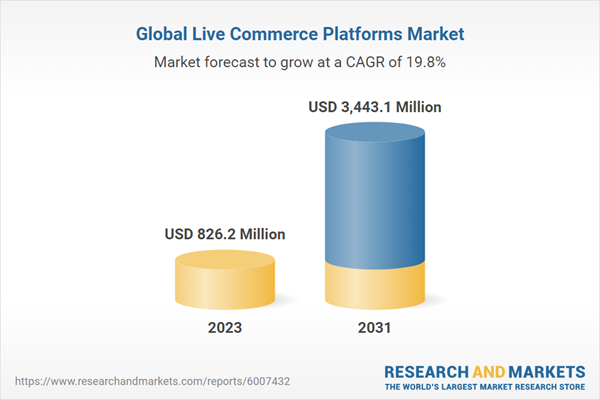The Global Live Commerce Platforms Market size is expected to reach $3.4 billion by 2031, rising at a market growth of 19.8% CAGR during the forecast period.
Fashion and apparel products are inherently visual, and their appeal largely depends on how they look when worn or styled. Live commerce allows brands to showcase clothing, accessories, and fashion items in real time, with models or influencers demonstrating how the products fit, move, and look under different lighting conditions. This visual demonstration is far more effective than static images or videos, as it provides a dynamic and interactive way for consumers to see the products in action, significantly driving demand in this segment. Thus, the apparel & fashion segment garnered 40% revenue share in the live commerce platforms market.
The real-time nature of these promotions creates a sense of urgency and exclusivity that encourages viewers to make immediate purchases to avoid missing out. This urgency, combined with the interactive aspects of live shopping, significantly boosts sales and drives the adoption of live commerce platforms. Therefore, the rising popularity of real-time interactive shopping experiences propels the market's growth.
Additionally, the ability to interact with influencers and brands in real time adds a personal touch to the shopping experience, increasing consumer satisfaction and loyalty. In conclusion, increasing adoption of social media and influencer marketing is driving the market's growth.
However, the cost of maintaining high uptime and resolving technical glitches can be significant. Producing live commerce events involves additional expenses, such as hiring hosts or influencers, setting up production studios, and managing live broadcasts. Costs may also include pre-event preparation, rehearsals, and post-event editing. These production costs can accumulate, especially for businesses that frequently conduct live events or promotions. Thus, the high costs of implementing and maintaining live commerce technology drive the market's growth.
The leading players in the market are competing with diverse innovative offerings to remain competitive in the market. The above illustration shows the percentage of revenue shared by some of the leading companies in the market. The leading players of the market are adopting various strategies in order to cater demand coming from the different industries. The key developmental strategies in the market are Acquisitions, and Partnerships & Collaborations.
Driving and Restraining Factors
Drivers
- Rising popularity of real-time interactive shopping experiences
- Increasing adoption of social media and influencer marketing
- Rapid internet penetration worldwide
Restraints
- High costs of implementing and maintaining live commerce technology
- Risk of content saturation and viewer fatigue
Opportunities
- Rising investment and funding in live commerce startups
- Increasing focus on omnichannel retail strategies
Challenges
- Privacy and security concerns associated with online transactions
- Integration issues with existing e-commerce systems
Category Outlook
Based on category, the market is divided into apparel & fashion, cosmetics & personal care, consumer electronics, entertainment, furnishing, and others. In 2023, the consumer electronics segment held 13% revenue share in the market. Consumer electronics often come with technical details that consumers may not fully understand.
Regional Outlook
Region-wise, the market is analyzed across North America, Europe, Asia Pacific, and LAMEA. In 2023, the North America region generated 29% revenue share in the market. Influencer marketing is a well-established trend in North America, with influencers and celebrities significantly influencing consumer purchasing decisions.
List of Key Companies Profiled
- Amazon.com, Inc.
- Google LLC (Youtube, LLC)
- com Ltd.
- iShopShops, Inc.
- Bambuser AB
- CommentSold, Inc.
- Loop Now Technologies, Inc. (Firework)
- TalkShopLive, Inc.
- Livescale Technologies Inc.
- GhostRetail Inc.
Market Report Segmentation
By Category
- Apparel & Fashion
- Cosmetics & Personal Care
- Consumer Electronics
- Furnishing
- Entertainment
- Others Category
By Geography
- North America
- US
- Canada
- Mexico
- Rest of North America
- Europe
- Germany
- UK
- France
- Russia
- Spain
- Italy
- Rest of Europe
- Asia Pacific
- China
- Japan
- India
- South Korea
- Singapore
- Malaysia
- Rest of Asia Pacific
- LAMEA
- Brazil
- Argentina
- UAE
- Saudi Arabia
- South Africa
- Nigeria
- Rest of LAMEA
Table of Contents
Companies Mentioned
- Amazon.com, Inc.
- Google LLC (Youtube, LLC)
- giosg.com Ltd.
- iShopShops, Inc.
- Bambuser AB
- CommentSold, Inc.
- Loop Now Technologies, Inc. (Firework)
- TalkShopLive, Inc.
- Livescale Technologies Inc.
- GhostRetail Inc.
Methodology

LOADING...
Table Information
| Report Attribute | Details |
|---|---|
| No. of Pages | 134 |
| Published | September 2024 |
| Forecast Period | 2023 - 2031 |
| Estimated Market Value ( USD | $ 826.2 Million |
| Forecasted Market Value ( USD | $ 3443.1 Million |
| Compound Annual Growth Rate | 19.8% |
| Regions Covered | Global |
| No. of Companies Mentioned | 10 |









